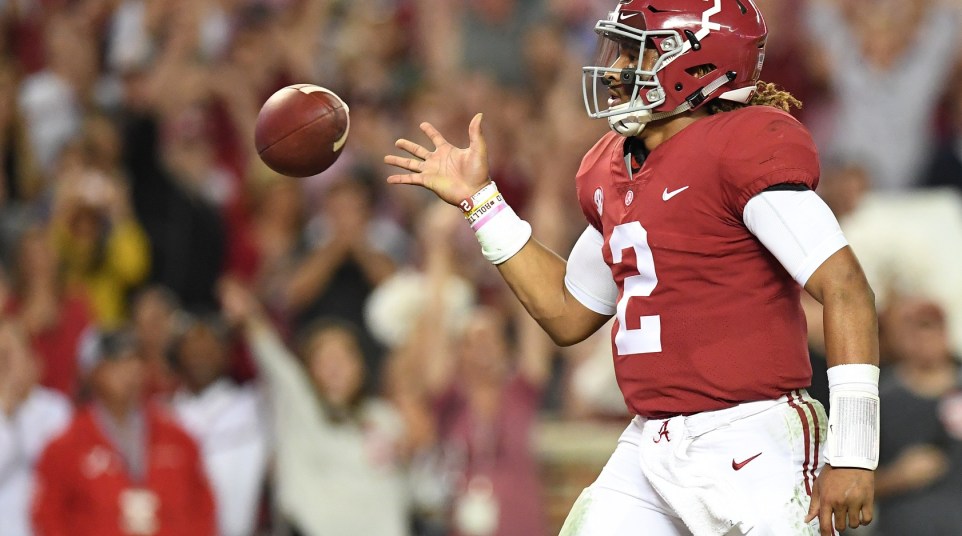
Numbers don't come close to showing how well Jalen Hurts played against LSU
Jalen Hurts won’t ever be a pure pocket passer, and that’s OK. Forcing that style of play on him wouldn’t allow him to reach his full potential.
There are critics constantly calling for Hurts to improve as a passer, and they point to his raw, basic statistics to back up their point that he hasn’t.
To put it mildly, that approach is lazy analysis, and it’s getting old.
Hurts’ passing stats from Saturday night’s game against LSU don’t jump off the page — he was 11 for 24 (45.3-percent) for 183 yards passing and a touchdown — but this might have been his best performance of the season as a passer.
Especially considering the timing of some of his plays.
Hurts was particularly effective on third down, which was critical. He converted a third-and-long on all four of Alabama’s scoring drives. More than half of his completions came on third down, and most of those were in obvious passing situations. That’s less than ideal for any quarterback.
[table “” not found /]
His succeess might sound surprising considering two weeks ago against Tennessee might have been one of his worst, but there was clear development between that game and what we witnessed against the Tigers.
First, let’s take into account things such as dropped passes (3), throw aways (1) and batted balls at the line of scrimmage (1), which accounted for 5 of Hurts’ 13 incompletions.
That still leaves eight “raw” incomplete passes for the sophomore — which isn’t great — but the 45.3-percent completion rate doesn’t properly reflect his accuracy. In fact, there are only four balls that Hurts threw that could be called a poor throw:
I only saw four balls that Hurts threw against LSU that I would consider “poor” throws. pic.twitter.com/o7O6aXj3wA
— Clint Lamb (@ClintRLamb) November 7, 2017
One of those four was a completion to Robert Foster, but it was still listed. That only leaves three incompletions that should reflect poorly on Hurts’ accuracy and decision-making.
On the flip side, there was a lot of positives, including his willingness to do two things: 1) detect pressure and move within the pocket and 2) keep his eyes downfield when he was forced to escape pressure.
Hurts also did a much better job not panicking as often and keeping his eyes downfield. pic.twitter.com/2mBBQHqsCC
— Clint Lamb (@ClintRLamb) November 7, 2017
There seems to be a calmness about him in the above clips. Even when having to deliver sideline passes on the run or throw it away on a roll out, he didn’t seem to panic.
Another thing that Hurts has improved on this season — that is just now starting to reflect on the stat sheet — is his deep accuracy.
Hurts started the year 1-for-18 (5.6-percent) on passes traveling 20 or more yards downfield. Critics pounced, but like we mentioned in a previous article, the stats didn’t tell the whole story — due to drops, penalties and other unfortunate circumstances.
Well, don’t look now, but Hurts is 7-for-12 (58.3-percent) on passes of 20 yards or more since that woeful start.
Against LSU, he was 2-for-6 (33.3-percent), but one of the deep incompletions was another drop. Here are all six attempts from the game:
By my calculations, Hurts was 2 for 6 (33.3%) on passes of 20+ yds against LSU, including 1 drop.
He’s 7-12 (58.3%) since starting 1-18. pic.twitter.com/RguRJ3zfHN
— Clint Lamb (@ClintRLamb) November 7, 2017
Overall, it was an excellent performance. It was the lowest completion percentage for Hurts all season — and the 183 passing yards were only the fourth-most from him — but it he showed improvement in a lot of areas.
One thing that Nick Saban, Brian Daboll and the rest of the Alabama coaching staff never want to do is take away Hurts’ instincts to be able to do this:
Of course, let’s not forget about Hurts’ ability to do these types of things. That cut in the second clip was 👌🏼 pic.twitter.com/iryhI1vJ9a
— Clint Lamb (@ClintRLamb) November 7, 2017
The thing that makes Hurts so dangerous is his legs. He has the size, power and elusiveness to be as effective a running back or receiver in the open field.
For now, the 2016 SEC Offensive Player of the Year has more than enough to cause defenses trouble, and with his continued development as a passer, this Alabama offense could be even better down the stretch.
